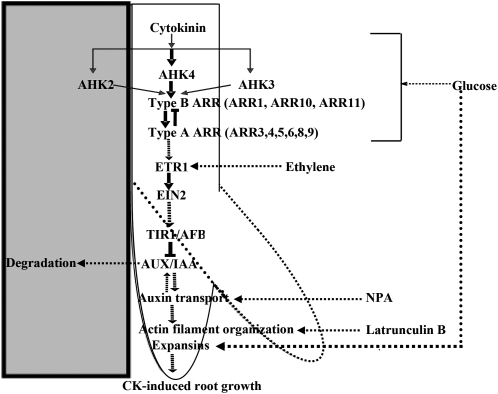Figure 9.
Testable model explaining the interactions among various signals involved in the CK-induced root growth response. CK leads to the CK-induced root tip growth response (Fig. 1, A–C), which is potentiated by Glc. Asymmetrical exposure of CK at the root tip promotes cell elongation without affecting cell division (Fig. 3). This CK-induced root growth involves the two-component system employing AHKs and type A and type B ARRs (Fig. 4). Glc may affect the response either by affecting the expression of different CK signaling elements (Supplemental Fig. S2) or increasing the expression of expansin gene family members (Supplemental Fig. S4A). Ethylene signaling components ETR1 and EIN2 work downstream of CK to transduce the signal further (Fig. 5A). Ethylene signaling but not biosynthesis is important (Fig. 5B) for promoting this response. Auxin signaling is also involved, since auxin receptor and signaling mutants dramatically reduced CK-induced root growth (Fig. 6A). Auxin signaling works downstream of both CK and ethylene, since auxin signaling gain-of-function mutants do not show this response when CK, ethylene, or both are applied together (Fig. 6B). The auxin transport- and root gravitropism-defective mutant eir1 did not display the CK-induced root growth response, suggesting a role for auxin transport and gravitropism (Fig. 6C). Differential distribution of auxin lies downstream of all the other factors mentioned above, since NPA can promote this root growth in all CK, ethylene, and auxin signaling mutants (Fig. 6F). Differential auxin transport may cause differential cell elongation across the root by disrupting actin filament organization, since Lat B can induce root growth even in the eir1 auxin polar transport-defective mutant (Fig. 7B).

